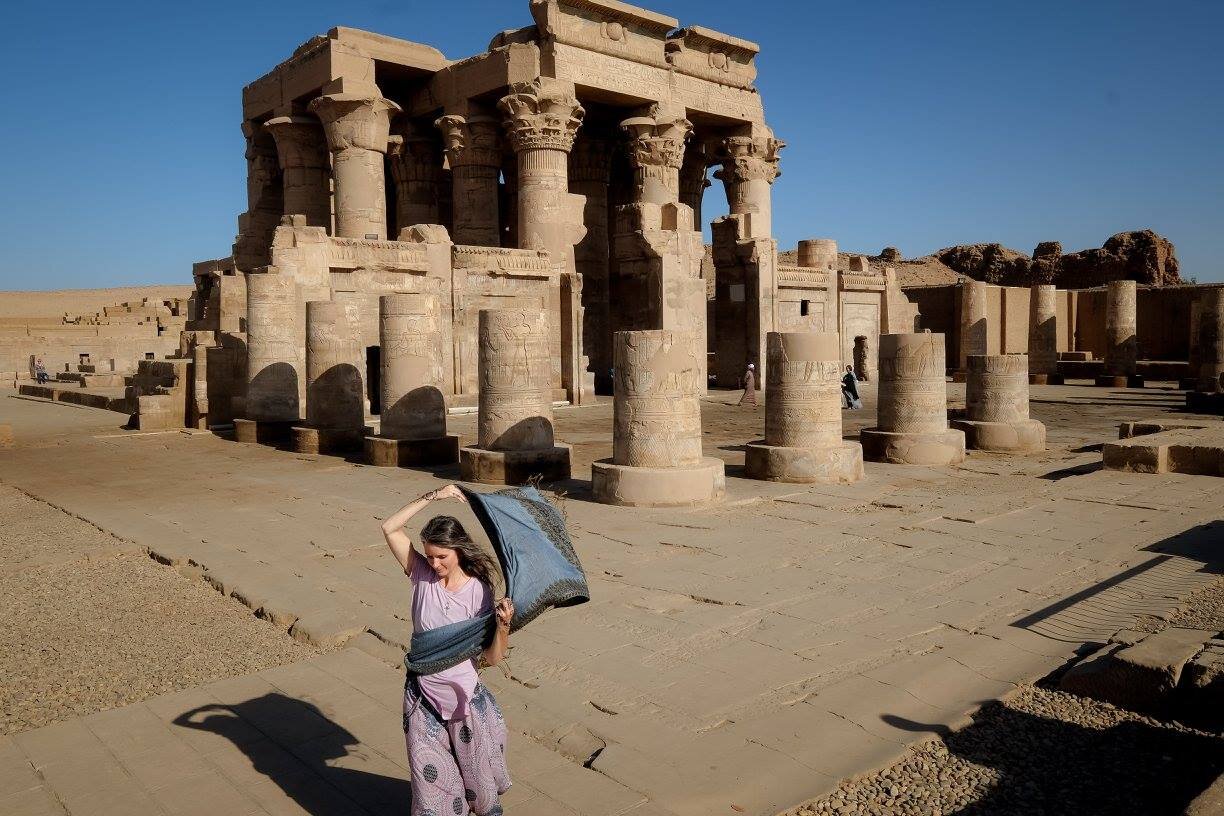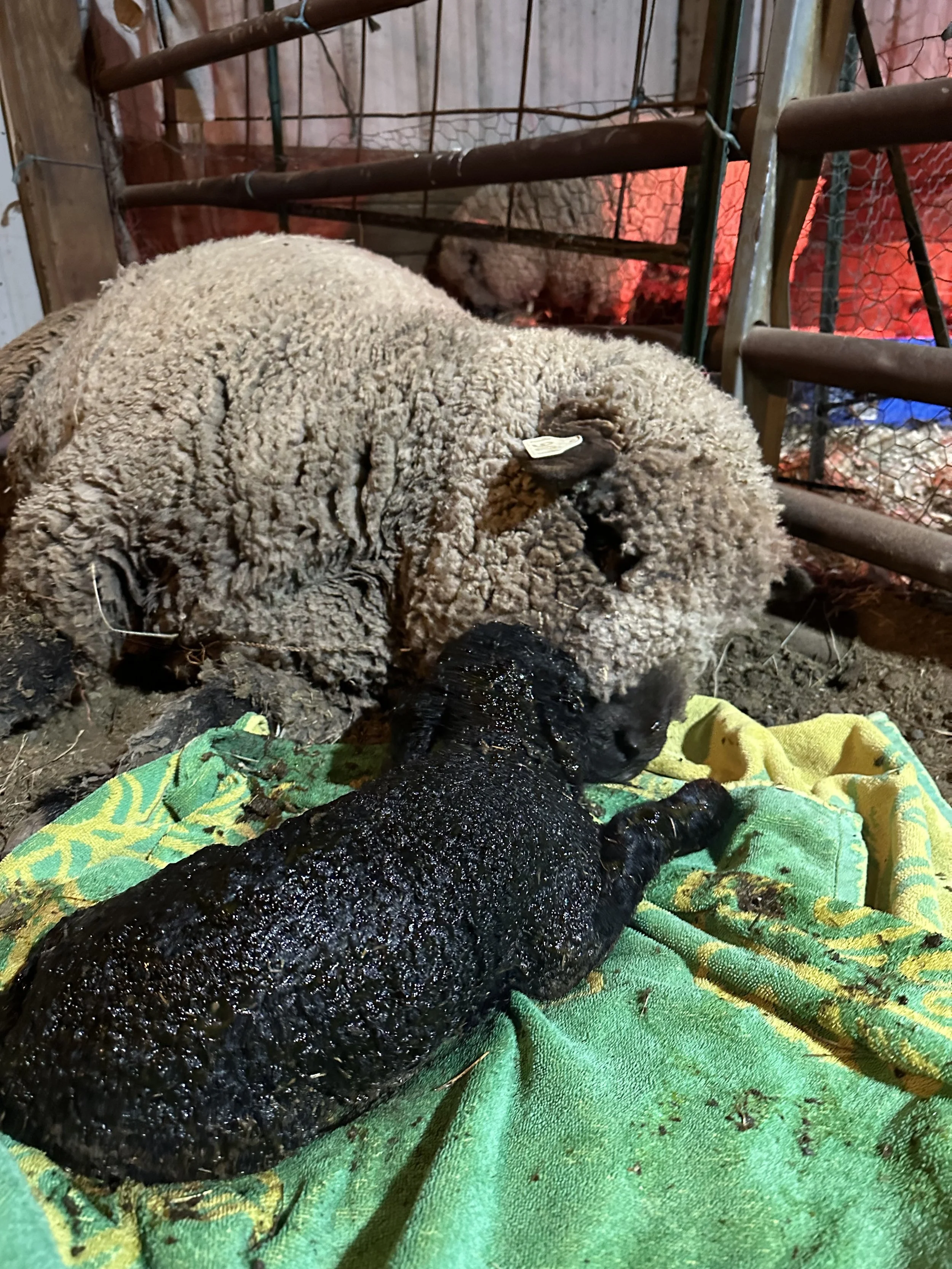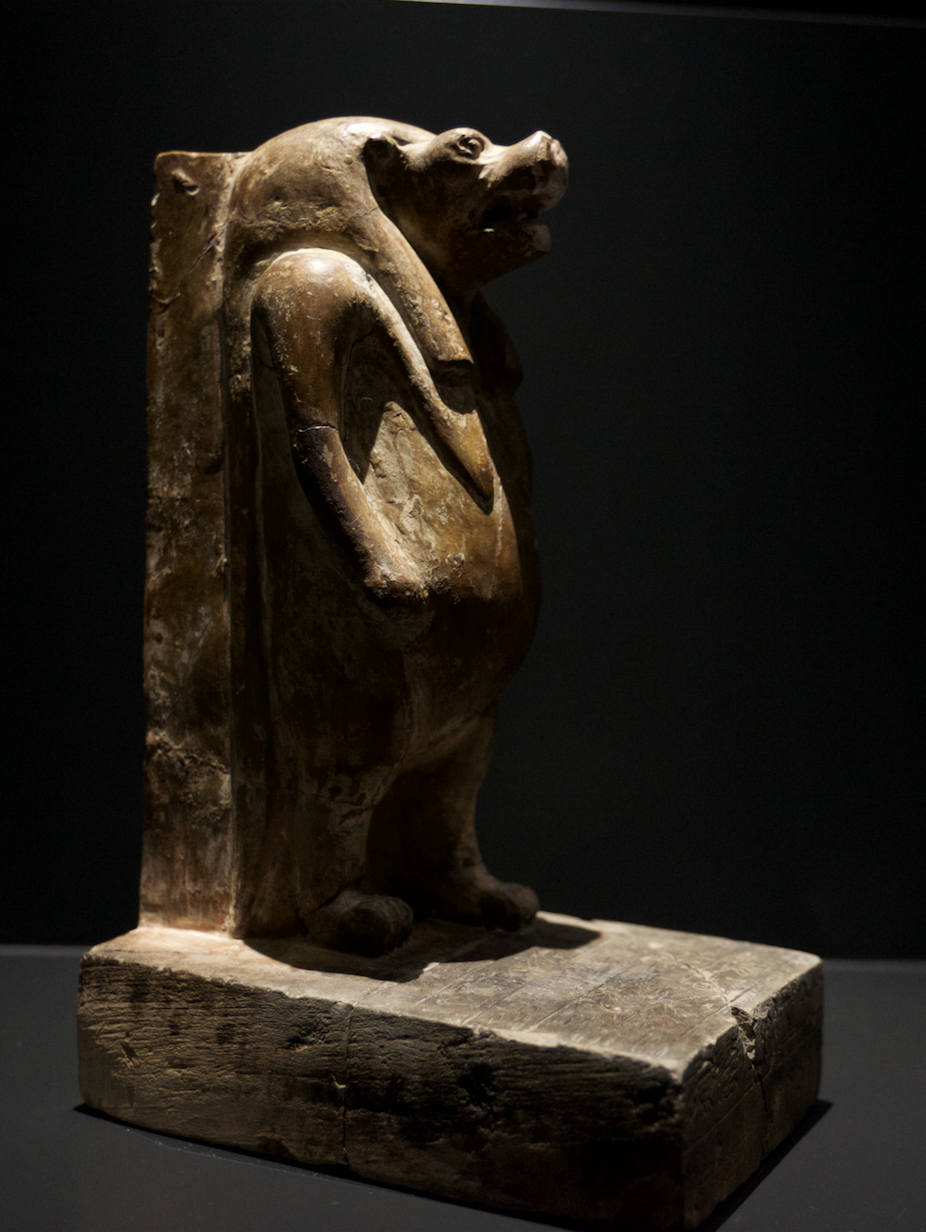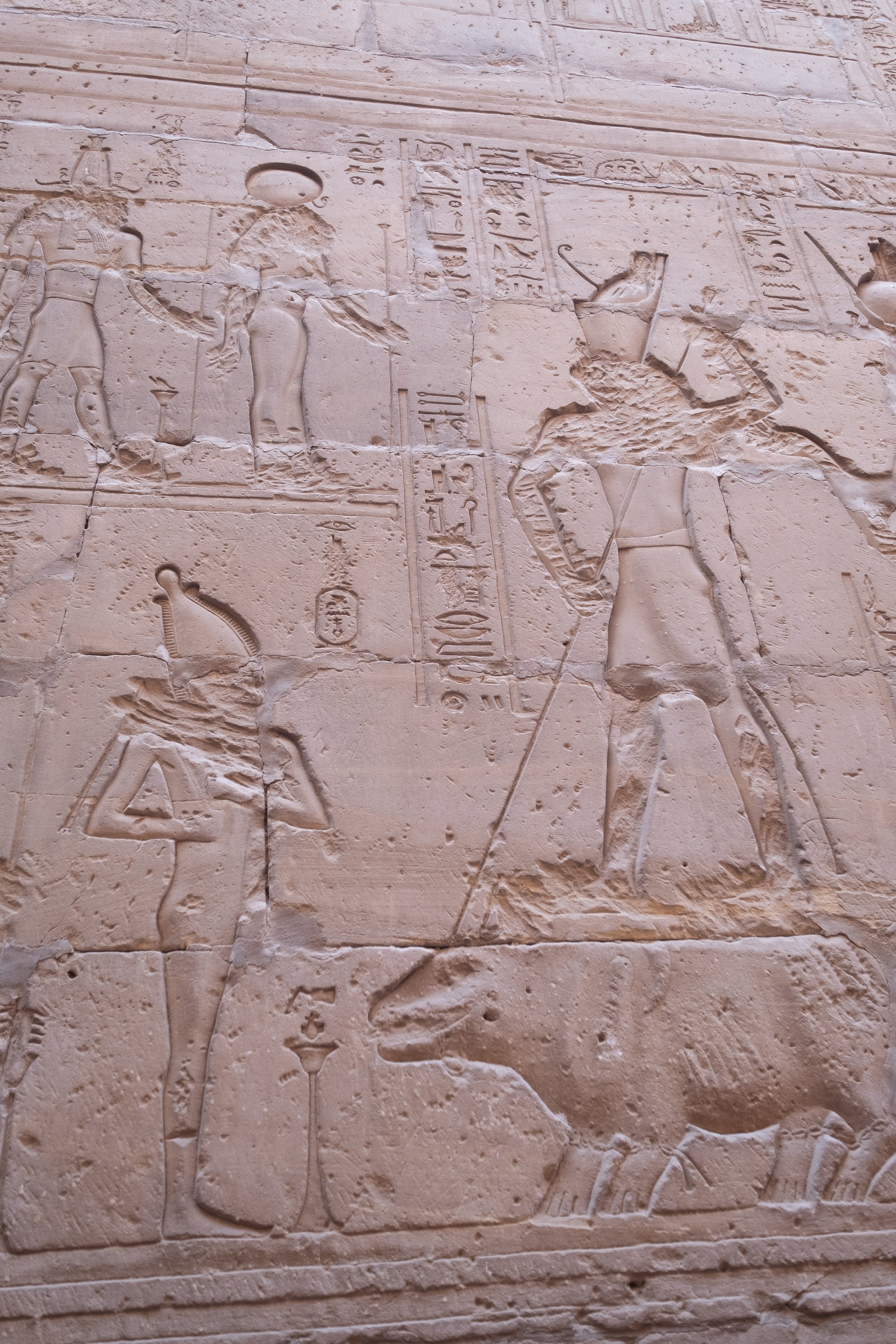The Hippopotamus, the Crocodile, and YOU (…and ewe)!
When you look at the art on the walls of Ancient Egyptian tombs, you can see a story unfold. The stories are about life and its joys, the everyday experiences one also expects to experience in the afterlife, and some really intricate depictions of deeper Ancient Egyptian mysteries and beliefs. One such drawing is a compelling image of a hippopotamus giving birth while a crocodile waits patiently behind her with its mouth open to eat it!
I was recently reminded of this image on the first day of Spring when I helped one of our ewes give birth to a lamb! It had been quite a while since I had been hands on in assisting a birth but I could tell that the ewe was struggling so I checked to be sure the lamb was presented in the proper way, with its little nose first and both front feet ready to enter the world. I reached in and felt all the right body parts and so went about getting a good grip on one of the forelegs and pulling it forward when the ewe pushed to shift the tiny shoulders and make their entry into the world easier. It worked like a charm and she came out all shiny and wet, steaming in the cold night air while the mother lay there exhausted. I wiped the fluid away from the tiny lamb’s nose and face and then picked her up and placed her in front of her tired mama, who sat up quickly and began licking her and talking to her. Since it was so cold I did help her dry her a little but the tough part was over and all that was left to do was to let them bond and get to know each other. It was so sweet and really fun to have this experience again after all these years.
It was a cold but beautiful night and while the new little lamb, her mom and the other ewes and lambs were safe inside the barn we heard the dogs outside begin howling with the coyotes who were probably a quarter mile away. While I sat there watching the new lamb with her mom and the sweetness of new life, we all listened to the dogs and howling. I couldn't help but wonder what the sheep thought about all of that and if they were happy to be in the cozy barn all safe and sound. I also thought about spring, creative forces, and how the Ancient Egyptians portrayed the life-death cycle in their art.
One such place is in the tomb of Indut, a daughter of the fifth dynasty pharaoh Unas, at the necropolis of Sakkara where we see a hippopotamus giving birth to her calf while a crocodile waits behind her with his mouth open ready to eat it! But why look into this particular portion of the tomb art? Because we can learn something from it that goes beyond what it might appear to mean at first glance. Let’s look at it in more detail!
The hippopotamus in Ancient Egypt
The hippopotamus in Ancient Egypt was depicted in more than one way, which might be a little confusing at first. The male hippopotamus could represent the god of chaos and destruction, Set. There are often scenes of hunting the hippopotamus in statues or in tombs and this was a way to show dominance over chaos and keeping life in balance. Inside the tomb of the Pharaoh Tutankhamun there was a little statue of the king spearing a hippopotamus and on the walls of the temple of Edfu we see the fierce battle between Horus and Set on the outer wall in which Set is in the form of a hippopotamus being speared by Horus. In each of these instances, the king is prevailing over chaos as Pharaoh Tutankhamun or Horus, and the chaos is being represented by the hippopotamus being speared.
This alignment of overcoming chaos is connected with the Goddess of balance, Ma’at, was also an integral part of the daily life of the non-royal Ancient Egyptian and something that was extremely important in both life and the afterlife. After all, it was Ma’at, the goddess of balance and order, that you encountered when you died. It was her scale and feather of truth that were used to weigh your heart and determine if you had indeed lived a life in balance or if you would be tossed into the abyss along with your erring heart into the jaws of the terrible monster, Ammut, the crocodile-lion-hippopotamus creature that swallowed you into oblivion! The ultimate decent into destruction and chaos for the soul!
The female hippopotamus was also a little fierce but she had a softer side as a representation of motherly protection, fertility and creation. She was known as Tauret (sometimes spelled Taweret) Ipet, or Reret, and small statues of hippopotami in blue faience were found in tombs to provide protection and new life for the deceased. She was benevolent and nurturing, loving and comforting …. and when one was in the afterlife, I can imagine that having her with you would give you peace of mind for sure!
The crocodile in Ancient Egypt
The crocodile in Ancient Egypt had destructive, fierce and protective aspects and is mentioned in each role within the ancient texts, such as the Pyramid Texts and later Coffin Texts and Book of Coming Forth by Day (the Egyptian Book the Dead"). Within the Pyramid Texts there are utterances that describe the king’s birth as the crocodile son of the goddess Neith. The Coffin Texts transform the deceased into the fierce crocodile to fend off harm in the afterlife, and the Book of Coming Forth by Day has a compelling spell to “become the crocodile” as well. The crocodile could represent Set, the god of chaos and destruction, and the destruction and chaos he could bring.
One of the most common forms of the crocodile is that of the god Sobek, who was both maleficent as well as beneficient. He was called upon for protection in the afterlife….who better to protect you from chaos than one who was an expert at it? Within the Fayoum and in the area of Kom Ombo, the god Sobek was an important deity and many mummified crocodiles have been discovered that were offerings to Sobek for protection and strength. At various times in the history of Ancient Egypt, Sobek merged with Horus as a representation of the king and later the deceased (non-royal person). One of my favorite little statues of Sobek as the king/Horus is now at the British Museum in which the crocodile wears a atef crown, connecting him with the Osiran cycle and the afterlife.
Tomb scene and what this means for YOU today….
When we see the image in the tomb of Indut of the hippopotamus giving birth into the mouth of the crocodile, we’re seeing a couple of things.
** When you read this next portion, I want you to read through it slowly or perhaps even out loud, to allow the words and concepts to come to life in your mind’s eye and bring clarity and insight. I’ll use bullet points to help you visualize and focus on each concept
Within the hippopotamus giving birth to the baby hippopotamus, we’re seeing that chaos can bring more chaos into the world.
Within the image of the crocodile waiting to eat the new life, we’re seeing the element of destruction that is possible in every life and new endeavor.
Within the composite of the entire image we’re seeing the destruction of chaos by the one who also brings chaos and the protection of the world that takes place when chaos is devoured and is no longer a threat.
ALL of these elements can be applied to our life today….
We all have the potential to embody each aspect of both the hippopotamus and the crocodile in this scene.
We all have the potential to create chaos in our life.
We all have the potential to perpetuate chaos that may already be in place in our relationships and daily life.
We all have the possibility that something we’re nurturing and tending to, such as projects or goals and ambitions, will finally launch and come into being only to be besieged with difficulty and destruction.
We all have the choice to end chaos and drama in our lives once and for all.
We all have the opportunity to protect ourselves from our own destructive thought patterns and actions.
How to work with these concepts
Some of the ways you can work with these concepts is to either journal your thoughts or to go into meditation for insight. You can use each of the bullet points above to journal your thoughts and write out ways that you embody the crocodile or the hippopotamus. You can write about the “why” you create chaos, if you feel that chaos is happening TO you rather than being created BY you and what you can do to shift that. You can write about potential outcomes if you embody the hippopotamus or the crocodile to write in advance what you want to create and how you want to overcome chaos in your life. You can write about ways in which you embody BOTH the creator of chaos and the one who can overcome it!
If you choose to meditate you can do this after you journal some of the prompts above or you can choose to only meditate on the answers to visualize your life as the hippopotamus or the crocodile. This can help you to see things as they can potentially be and empower you to make any changes that might be needed for a life with less chaos or destructive thought patterns and actions.
Either way you can also incorporate a ritual or a candle-lighting or incense offering to the crocodile gods or the hippopotamus goddesses to bring you clarity as you write or go into a visual meditation. Feel their presence beside you guiding your words and visions.
The art of Ancient Egypt is full of wisdom if you sit with it and allow it to speak to you! I hope that you enjoyed a deeper look into some of the art within the tombs of Ancient Egypt and that this will help you to overcome the chaos in your own life!
Let me know in the comments what you might do in your life to overcome the chaos and drama that is holding you back….I’m all ears!
** All images taken by Amy Auset Rohn





